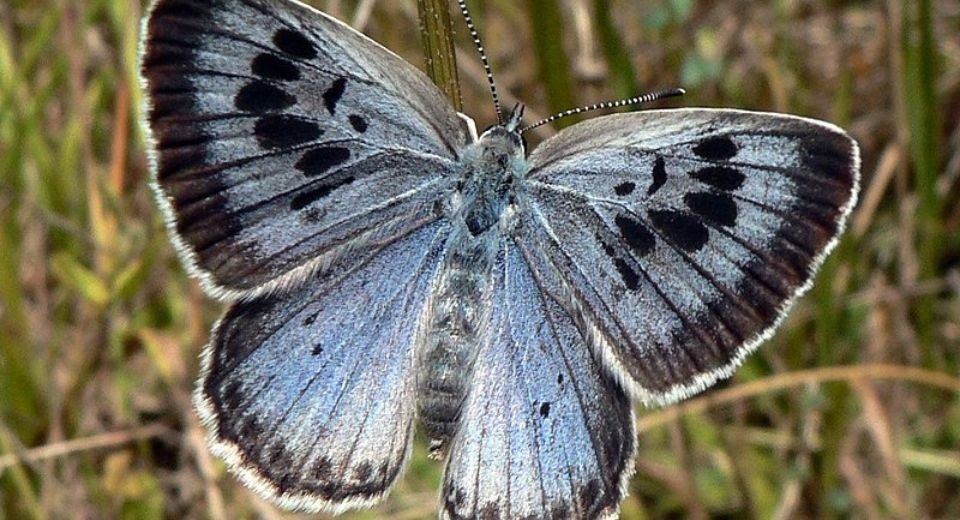HQ Team
July 15, 2023: Butterflies with smaller or lighter-colored wings are likely to be “losers” during climate change, with the 6,000 species of Lycaenidae family in the tropics being the most vulnerable, according to a study.
Ecologists at the University of Cambridge found that the family, wing length, and color of tropical butterflies influenced their ability to withstand hot temperatures.
The nymphalidaes with larger or darker colored wings are likely to fare better under increasing temperatures — only to a point. Researchers say these butterflies could still experience dramatic declines if there were sudden heatwaves or if cool microclimates were lost through deforestation.
Butterflies depend on the sun’s warmth to give them the energy they need to function. They use ‘thermoregulation’ strategies to maintain a balanced body temperature against changing air temperatures.
The strategies to keep cool involve adaptive behaviors like flying to a shady spot or angling the wings away from the sun (thermal buffering).
Thermal tolerance
When this is not possible or temperatures become too hot, species have to rely on physiological mechanisms such as the production of heat shock proteins to withstand high temperatures (thermal tolerance).
Both of these strategies are needed to cope with climate change.
Researchers collaborated with the Smithsonian Tropical Research Institute (STRI) to study the thermal buffering and thermal tolerance strategies of tropical butterflies. They collected data from multiple habitats in Panama.
Ecologists took the temperature of over 1,000 butterflies using a tiny thermometer-like probe.
They compared each butterfly’s temperature to that of the surrounding air or the vegetation it was perched on. This gave a a measure of thermal buffering – the ability to maintain a steady body temperature against fluctuating air temperatures.
A second experiment was conducted at STRI Gamboa facilities and involved assessing butterflies’ thermal tolerance – their ability to withstand extreme temperatures, such as those they may experience during a heatwave.
Glass jars
This was assessed by capturing a subset of butterflies and placing them in glass jars within a water bath – the temperature of which was steadily increased. Thermal tolerance was assessed as the temperature at which butterflies could no longer function.
Butterflies that had large wings tended to have greater thermal buffering ability, but less thermal tolerance than smaller butterflies.
“Butterflies with physical characteristics that may help them to avoid the sun’s heat, like having large wings that enable them to fly quickly into the shade,” said lead author Esme Ashe-Jepson, a PhD student at Cambridge’s Department of Zoology.
They “rarely experience high temperatures, and so have not evolved to cope with them. On the other hand, species that can cope with higher temperatures physiologically have experienced less selective pressure to evolve heat-avoiding behaviors.
“As temperatures continue to rise, and forest fragments get smaller and further apart because of deforestation, butterflies which rely on their surroundings to avoid high temperatures may not be able to travel between forest fragments, or cope with increasingly common heatwaves.”
Darker-winged butterflies
In a further study conducted by the same research team, butterflies with larger, longer and narrower wings were found to be better at thermal buffering.
Thermal buffering abilities were found to be stronger in darker-winged butterflies who could also tolerate higher temperatures than paler-winged butterflies.
Butterflies of the Lycaenidae family ,which have small, bright, and often iridescent, wings had the poorest thermal buffering and low thermal tolerance.
If temperatures continue to rise at the current rate, forests continue to be cut down, and cool microclimate’s are lost, there is a very real threat that we could lose many species in this family in the future, according to ecologists.
Around the world, a majority of native butterflies are on the move as a result of local climate warming. They are leaving their natural homes and taking up residence in places with cooler average temperatures. This phenomenon has been well-documented in Europe and the United Kingdom.
Although the latter is a region historically home to few moths and butterflies, in the last century alone some 89 species of these insects have migrated there permanently, having flown north from southern Europe.
“Ultimately, all insects, including butterflies, the world over are likely to be affected by climate change,” said Ashe-Jepson. “Adaptation to climate change is complex and can be impacted by other factors such as habitat destruction. We need to address these two global challenges together.”








